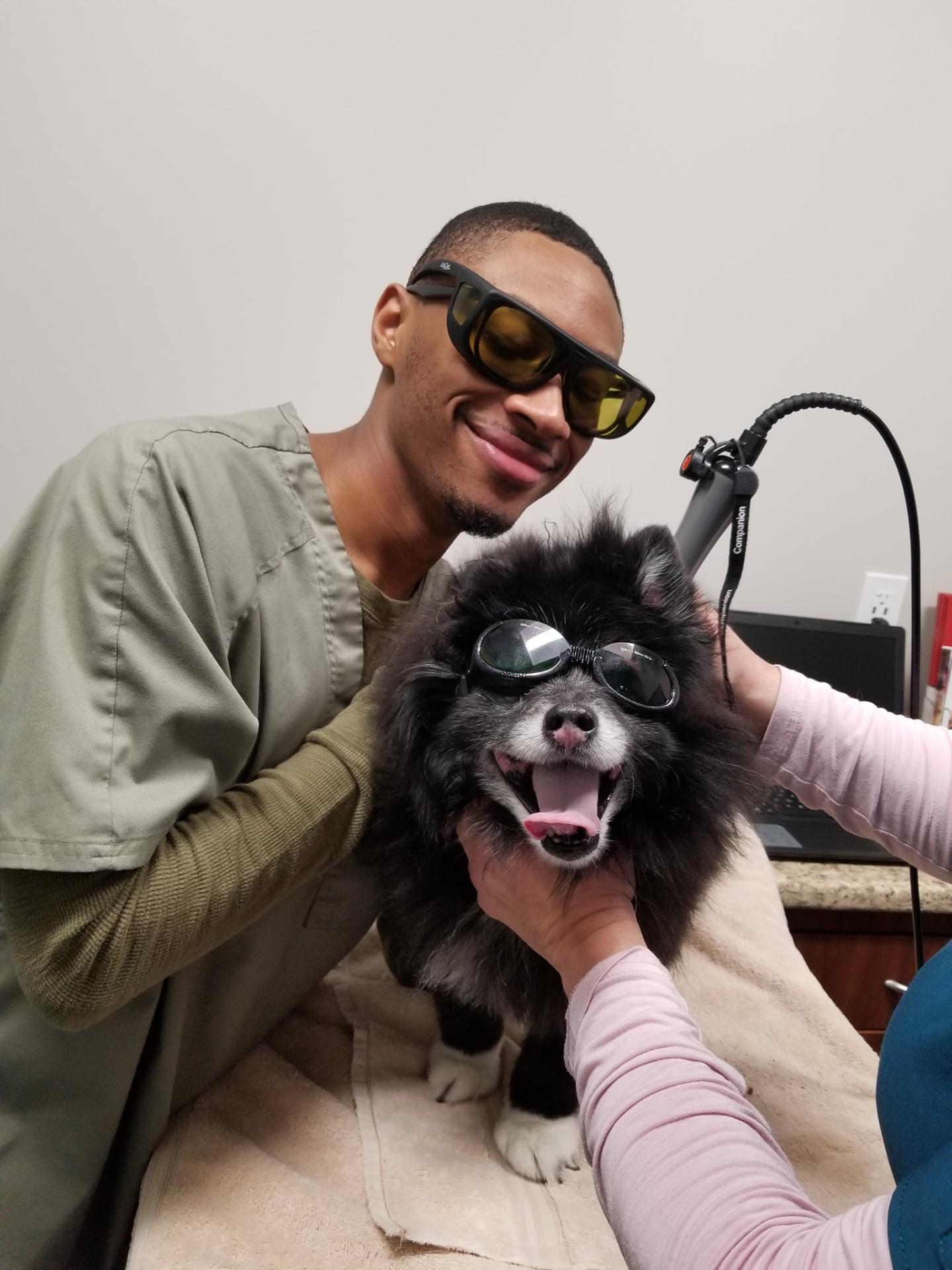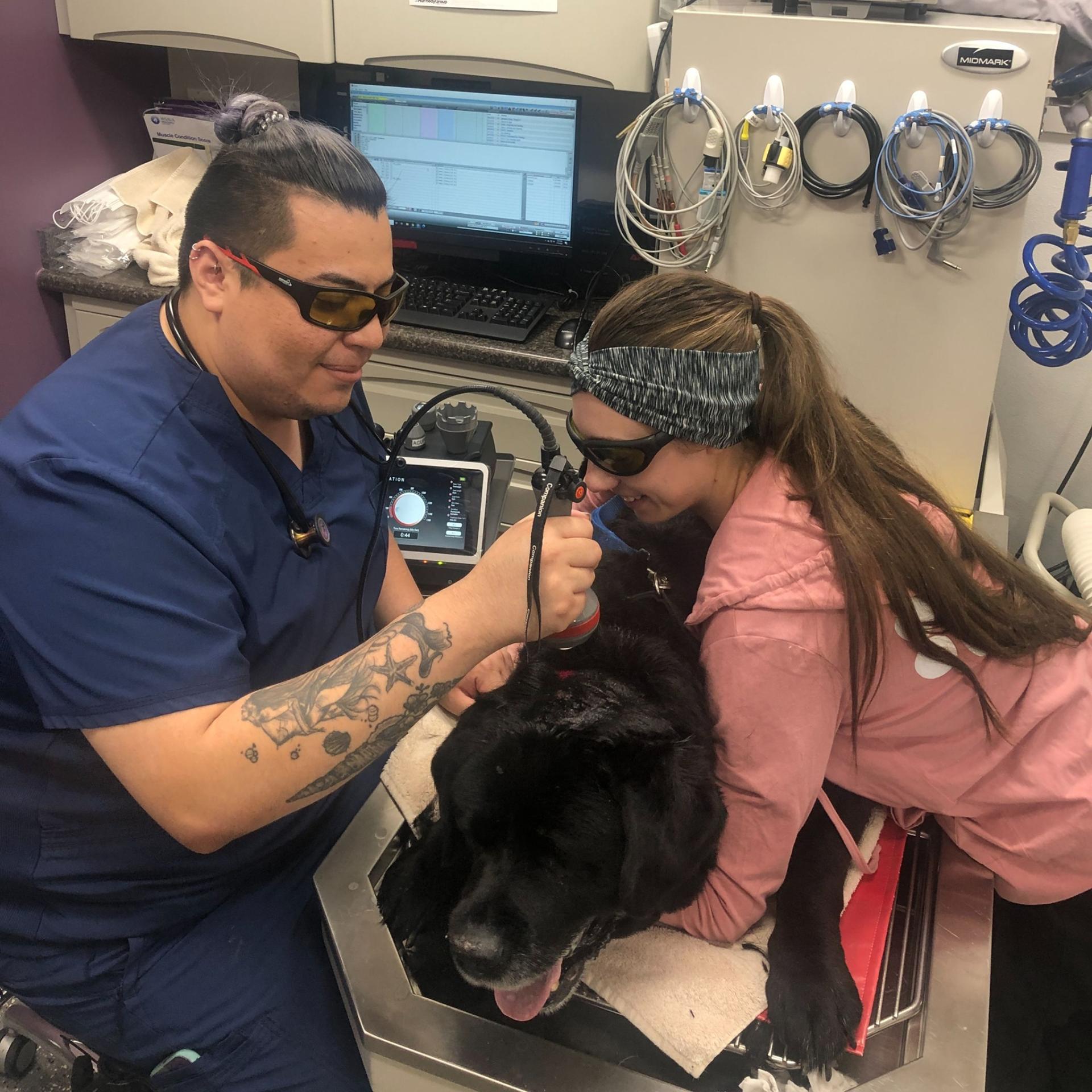 Laser therapy (or photobiomodulation) is applied with the Companion Therapy Laser System. Laser Therapy provides a sterile, pain-free, surgery-free, drug-free treatment which is used to treat a variety of injuries, wounds, fractures, neurological conditions, numerous dermatological problems, and general pain. Whether your pet is rehabilitating from trauma, injury or healing wounds, or if your pet suffers from joint pain or arthritis, your companion will benefit from this revolutionary new approach to regenerative Veterinary medicine.
Laser therapy (or photobiomodulation) is applied with the Companion Therapy Laser System. Laser Therapy provides a sterile, pain-free, surgery-free, drug-free treatment which is used to treat a variety of injuries, wounds, fractures, neurological conditions, numerous dermatological problems, and general pain. Whether your pet is rehabilitating from trauma, injury or healing wounds, or if your pet suffers from joint pain or arthritis, your companion will benefit from this revolutionary new approach to regenerative Veterinary medicine.
Laser therapy (or photobiomodulation) is a treatment modality that stimulates the body to heal from inside out. Non-thermal photons of light are administered to the body and absorbed by the injured cells. The cells are then stimulated and respond with a higher rate of metabolism; this results in increased circulation from the body, an anti-inflammatory reaction, relief from pain and an acceleration of the healing process.
What to expect during a laser treatment?
The treatment provides quick relief of pain and inflammation.
As the treatment is going on, your pet may relax and enjoy the pressure of the roller ball on the hand switch, massaging your pet's affected joints or the mild warmth of the light beam coming from the cone application, depending on your pet's individual therapy. The near immediate relief of pain will allow your pet to be comfortable and any anxiety, that your pet may have initially experienced, will dissipate. Agitated feline companions may start to purr, and most of our canine companions will fall asleep during their session.
Frequently, after therapy, our clients state: "Our dog is back to normal", or "She's acting like a puppy again!"
Applications of the Companion Therapy Laser System
Companion Therapy photobiomodulation (or PBM) provides a revolutionary new approach to Veterinary Wound Management. It can significantly reduce the healing time. Traumatic skin injuries and surgical incisions benefit greatly from photobiomodulation (PBM) therapy.
- Enhanced leukocyte infiltration
- Increased macrophage activity
- Increased neovascularization
- Increased fibroblast proliferation
- Keratinocyte proliferation
- Promotion of early epithelialization
- Growth factor increases
- Enhanced cell proliferation and differentiation
- Increased tensile strength in wound healing
 General Information
General Information
Understand that treatment of arthritis is not curative. Helping your arthritic pet requires a comprehensive management plan. Photobiomodulation treatment is a part of the overall management plan, adding a significant reduction of pain and inflammation. For laser therapy to succeed, the right areas have to be treated by the technician or veterinarian. A complete orthopedic exam, including evaluation of the range of motion, and appropriate radiographs when needed, establishes which joints or areas require treatment. We will treat the affected joints and all tissues biomechanically involved with the joints, since chronic arthritis results in pain and inflammation in the muscles, tendons, and other soft tissue associated with the joint.
What about medications?
Patients undergoing initial evaluation for arthritis management and are not on medication for arthritis can begin laser therapy without starting medications. After the response to laser therapy has been noted and a maintenance schedule established, if additional relief is needed, then medications can be added to the management plan. Patients already on arthritis medication may begin laser therapy without any regimen change during initial laser therapy. Once response to laser therapy is determined, medications are adjusted and laser maintenance schedule is determined.
How will treatments be scheduled?
Osteoarthritis is treated through an "Induction Phase" of every other day (three times a week) treatments until a response is noted, followed by a "Transition Phase" of reduced frequency treatments, leading to a "Maintenance Phase" on a frequency required to maintain the effect. Most patients will show some improvement within 3-4 treatments during the "Induction Phase". This initial response is due to the pain-relieving effects of the therapy laser. However, most patients require more treatments before results ay be noticeable. Ten induction phase treatments are generally expected; some patients may require as many as 9-12. Only about 5% of patients will show no response to laser therapy. As treatments continue, there is a cumulative long term reduction of inflammation allowing the transition to the "Maintenance Phase". Most patients will require "Maintenance Phase" treatments every 3-4 weeks to maintain the effect.
Are there any adverse effects from the treatment?
Some patients will display increased soreness after the first 1-2 treatments; this is a result of vasodilation (increased blood flow) in the target tissues and subsides quickly without intervention.
Service FAQ
Will my dog accept LASER treatment?
Animals generally accept laser treatments very well indeed. Relaxation is the usual response. Our experience is that most patients willingly submit themselves to a second treatment, when offered, thus demonstrating their comfort with the process. The procedure is entirely pain-free.
What conditions/diseases can be helped by LASER treatment?
There is a wide selection of problems that can respond favorably to laser (PBM) therapy. The treatment of soft tissue injury, including muscles, tendons, ligaments, joint capsules, and bursae show much improvement using this therapy. Paralysis and painful conditions such as arthritis, back pain, and other back problems, nerve injury and intervertebral prolapse disc are typical cases seen for PBM therapy. Situations in which clients have reported most significant benefit include wound healing, ulcers, burns, wounds, cruciate ligament injury, sprain, strain, shoulder lameness, arthritis, elbow dysplasia, hip dysplasia, lick granuloma, head shaking (head shaking), back pain, back injury, ear disease, and disk disease.
What sort of cost can I expect?
It is always challenging to compare costs across different treatments but, in general, successful treatments are very cost-effective. Most chronic or long term conditions require 2-3 treatments per week for two weeks, then 1-2 times per week for an additional two weeks. After that, procedures will be done on a maintenance schedule, usually one treatment every one to three weeks. We also have laser treatment packages available that help reduce the pretreatment price. Please give us a call at (734) 453-0485, and we will be more than happy to provide you with an estimate for your pets’ treatment plan.
Is it safe?
The use of photobiomodulation therapy, when used according to specific guidelines, does not pose any unique risk to the patient. If you have questions not answered here, please call us!
